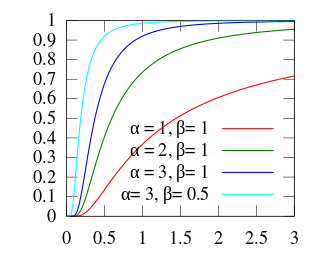Inverse-gamma distribution
|
Probability density function
| |
|
Cumulative distribution function
| |
| Parameters |
shape (real) rate (real) |
|---|---|
| Support | |
| CDF | |
| Mean | for |
| Mode | |
| Variance | for |
| Skewness | for |
| Ex. kurtosis | for |
| Entropy |
(see digamma function) |
| MGF | Does not exist. |
| CF | |
In probability theory and statistics, the inverse gamma distribution is a two-parameter family of continuous probability distributions on the positive real line, which is the distribution of the reciprocal of a variable distributed according to the gamma distribution. Perhaps the chief use of the inverse gamma distribution is in Bayesian statistics, where the distribution arises as the marginal posterior distribution for the unknown variance of a normal distribution if an uninformative prior is used; and as an analytically tractable conjugate prior if an informative prior is required.
However, it is common among Bayesians to consider an alternative parametrization of the normal distribution in terms of the precision, defined as the reciprocal of the variance, which allows the gamma distribution to be used directly as a conjugate prior. Other Bayesians prefer to parametrize the inverse gamma distribution differently, as a scaled inverse chi-squared distribution.
Characterization
Probability density function
The inverse gamma distribution's probability density function is defined over the support
with shape parameter and scale parameter .[1] Here denotes the gamma function.
Unlike the Gamma distribution, which contains a somewhat similar exponential term, is a scale parameter as the distribution function satisfies:
Cumulative distribution function
The cumulative distribution function is the regularized gamma function
where the numerator is the upper incomplete gamma function and the denominator is the gamma function. Many math packages allow you to compute Q, the regularized gamma function, directly.
Characteristic function
in the expression of the characteristic function is the modified Bessel function of the 2nd kind.
Properties
For and ,
and
where is the digamma function.
Related distributions
- If then
- If then (inverse-chi-squared distribution)
- If then (scaled-inverse-chi-squared distribution)
- If then (Lévy distribution)
- If (Gamma distribution) then (see derivation in the next paragraph for details)
- Inverse gamma distribution is a special case of type 5 Pearson distribution
- A multivariate generalization of the inverse-gamma distribution is the inverse-Wishart distribution.
- For the distribution of a sum of independent inverted Gamma variables see Witkovsky (2001)
Derivation from Gamma distribution
The pdf of the gamma distribution is
and define the transformation then the resulting transformation is
Replacing with ; with ; and with results in the inverse-gamma pdf shown above
See also
References
- V. Witkovsky (2001) Computing the distribution of a linear combination of inverted gamma variables, Kybernetika 37(1), 79-90

